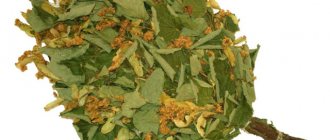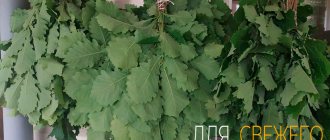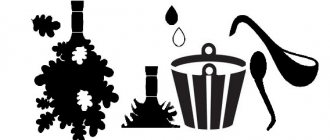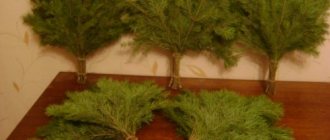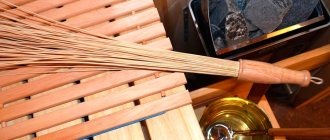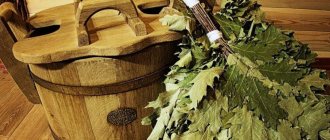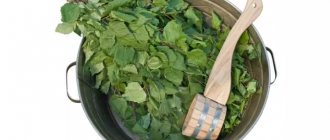In the modern world, people live in warm houses, houses with air conditioning. And a very important system of the human body, fundamental to the body, practically does not work. We are talking about a thermoregulation system that turns out to be virtually unclaimed. And only in the bathhouse does a person force her to work. The temperature and steam effects of the bath train the heart muscle, blood vessels, cleanse and rejuvenate the body. A bath is necessary at least once a week, but it must be correct. In order to prepare for a trip to it, you need to take into account many factors: what kind of broom you choose, what oils you use, depends on what effect the bath will give. This article will tell you everything about preparing for steaming, how to properly steam a broom and the advantage of a juniper broom over others.
The benefits of juniper brooms for baths
Juniper needles contain dozens of useful substances. It contains essential oils, phytoncides, antiseptic components, vitamins and organic acids.
A properly prepared broom has the following useful qualities:
Helps in relieving symptoms of joint diseases . Can be used in the treatment of arthritis, arthrosis, radiculitis, etc. Juniper helps relieve inflammation in tissues.
Heals the skin . The essential oils contained in juniper needles have a general healing and rejuvenating effect on the skin. They help fight acne and promote accelerated tissue regeneration.
Fights colds and bronchopulmonary diseases . You can use a broom for bronchitis, pneumonia, tuberculosis, etc. Essential oils have a mucus-thinning effect and suppress the action of pathogenic microflora.
Increases blood circulation in tissues . The skin becomes smoother, more elastic and well-groomed. By normalizing blood flow, the process of removing toxins and waste is accelerated.
Juniper broom has a complex effect on the entire body. Regular bathing procedures using a heather broom can boost immunity, get rid of skin diseases, cope with cold symptoms, cure ulcers and non-healing wounds.
Contraindications
Juniper broom is not recommended for use in the presence of the following conditions:
- severe skin damage, open wounds;
- pregnancy;
- diseases of the heart and blood vessels.
In addition, people with allergies to the plant will have to avoid using a broom.
The benefits of juniper
Juniper is a plant from the cypress family, growing from the Arctic to the subtropics and is a shrub with branches strewn with green needles. In common people, juniper is called veres, and its Turkic name is juniper. Since ancient times, juniper has been used in folk medicine for diseases of the kidneys and bladder, for colds, inflammatory processes, and also as an excellent remedy for various kinds of skin diseases - eczema, dermatitis. The healing effects of heather on the respiratory system are known. The healing substances contained in the roots of juniper help treat bronchitis and tuberculosis. Juniper oil helps with joint diseases and is used in the treatment of arthritis, polyarthritis, radiculitis, and neuralgia. In villages, juniper has long been used for steaming tubs before harvesting mushrooms, fruits and vegetables. Phytancides contained in juniper wood and needles are able to cope with most known harmful microorganisms.
According to popular beliefs, juniper is capable of expelling various evil spirits from the house. Therefore, they always tried to plant heather near the house in order to protect their home from evil spirits, and those living in it from damage and the evil eye.
When to prepare branches for a juniper broom?
Juniper is an evergreen plant, so you can collect raw materials for brooms in any season. However, depending on the time of year, the amount of nutrients in the needles and the stiffness of the branches will vary greatly.
If you want to start harvesting juniper branches, remember the following nuances:
- the highest concentration of nutrients in the needles is found in late May-early June;
- Branches should be harvested on a cool, dry day. This way the needles will fall off less;
- To create a broom, collect not only young flexible branches, but also stronger branches. They will act as the base of the broom.
Expert opinion
Lovkachev Boris Petrovich
Bath master who knows everything about steaming
Important! The ideal time for harvesting juniper raw materials for making brooms is the end of May-beginning of June. Branches with fruits are not suitable for making a broom.
Important rules for collecting raw materials
In order for the broom to be durable, beautiful and bring only benefits, you must adhere to the following rules:
Collect branches from bushes growing away from roads, power lines, city limits and factories . Do not forget that needles have the ability to accumulate toxic substances.
Take branches only from healthy plants . Do not touch bushes with signs of disease, damage from insects or chemicals.
Give preference to branches growing on the sunny side . Branches on the north side fall off much faster.
Cut branches at least 50 cm long . This is the optimal length for making a comfortable bath broom.
With proper selection and compliance with the listed rules, juniper branches will be elastic and pliable.
Juniper bushes grow slowly and take a long time to recover, so there is no need to cut off a large number of branches from one bush.
Brief botanical information
Despite the fact that this plant lives for a long time - about 600 years, it is one of those plant organisms that are difficult to reproduce in natural conditions. The variety of juniper species is quite wide. It can be found in tree-like forms, about 12-15 m high, and in the form of shrubs and creeping plants, which have become so popular recently among specialists in the field of landscape design.
Separately, it is worth mentioning the durum juniper - a unique plant that is popular in Japanese culture as a key element of the bonsai composition. The leaves of young plants are coniferous, but over time they transform into scale-like leaves. The highlight of the plant is the so-called coneberry, which finds the widest application in a wide variety of areas of human activity.
How to tie a fresh broom for a bath?
It is best to take the lower branches of the plant to make a broom. For one broom you will need 5-6 good, healthy branches.
The sequence of work is as follows:
- Before work, the collected branches should be washed with cold, clean water. This way you will wash away all the dust and dirt from them.
- After washing, place the raw materials in a well-ventilated and dry area on clean boards or newspaper and let them dry completely. It is very important that they are not exposed to sunlight. For example, the ideal place for drying may be the attic of a private house. Don't forget to turn the branches over from time to time.
- After the workpieces have dried, take several large and strong branches. Place them in the center. They will act as a base.
- Place younger and softer branches around the base, which will have a soft massage effect on the skin.
- Press the branches tightly and tie the bottom using linen rope or bast.
- Clean the bottom of the broom. Remove needles and branches that can injure your hand during bath procedures.
Juniper has fairly stiff needles, therefore, it is necessary to wear gloves when knitting a broom.
How to store juniper broom?
Juniper is a coniferous plant. You can get raw materials for making a broom at any time of the year, so there is no point in harvesting branches for use. In addition, professional bath attendants recommend using a fresh juniper broom in the steam room.
Heather brooms are not intended for drying, since when the branches dry out, the needles begin to fall off. If necessary, the finished broom can be stored at a temperature just above zero with fairly high humidity. However, the shelf life of the product in this case will be 2-4 weeks.
If you don’t have the opportunity to go for heather raw materials every time, you can freeze the finished broom. A fresh broom is wrapped in cellophane and stored in the cold or in the freezer.
The film will not allow moisture to evaporate and will keep the needles fresh. The broom can be stored in this form for 3-4 months.
Juniper brooms are the most capricious. Even with proper preparation of branches and proper freezing, such a broom can easily crumble after thawing. That is why experienced bathhouse attendants advise using heather brooms exclusively in fresh form.
Preparing a broom for use: brewing rules
Since juniper brooms have prickly needles and fairly stiff branches, they should not be used without first brewing them. They do this in two ways: soft and hard. The choice of one option or another depends solely on the preferences of the person. We'll look at both.
The hard way
When brewed using the “hard” method, the broom will retain its rigidity, the needles will remain quite hard and prickly. This broom is not suitable for hitting the body, but it can be used for a light massage, reminiscent of an acupuncture session.
So, for this you need:
- Pour boiling water over the prepared broom.
- After that, put it in cold water for 10-15 minutes.
- After the allotted time, the broom is completely ready for use.
You can also “brew” a broom in another way. To do this, wrap it in a wet, hot rag and leave it in a bathhouse on a shelf for about 1.5-2 hours.
Gentle steaming method
When steamed in this way, the broom becomes softer. It can be used for intense massage.
This is done as follows:
- Take a broom and dip it in cold water for 2-3 minutes. This way you will wash away dirt and dust from the needles.
- The prepared broom is dipped into a bucket of boiling water and kept for 30 minutes or more. Some bathhouse attendants advise steaming a broom for at least 2 hours.
- After the allotted time is up, the broom is shaken off from the water and used for its intended purpose.
Expert opinion
Yaremchuk Svetlana Sergeevna
The owner of a SPA salon knows everything about beauty treatments
The remaining water after steaming can be used to create steam. It contains many useful substances and microelements.
Juniper broom - useful and unusual
A juniper bath broom is like acupuncture and aromatherapy sessions. If used correctly, this medicinal plant can bring invaluable benefits to the body.
The needle leaves and cones of the plant, called “heather” by the Russian people, are a storehouse of valuable substances. A big plus of such brooms is the ability to prepare them all year round.
There are many secrets of caring for and using this ancient plant. It’s difficult to unravel all the mysteries; it’s easier to discuss the subtleties of its use.
The prickly “Mr. Bath” is a mass of useful substances, a blow to depression and sexual impotence.
Juniper in a Russian bath - exotic or traditional?
Perhaps some Russians will find it ridiculous to compare bath brooms made from different trees and herbs. But such unofficial ratings exist, they were invented by fans of various “foreign” charts. The top 10 brooms are headed by birch (who would doubt it!). What place does our “prickly hero” – veres – occupy?
The intrigued reader will be pleased with the rather high position of juniper broom in the “bath” rating. Due to its prickly properties, it ranks after cedar, spruce, fir or immediately after nettle.
It’s a little strange that not a single coniferous plant found a place among “7 types of Russian brooms for a week.” Although the very principle of creating this list is controversial, because Russians have long considered only Saturday to be a bathing day.
In Rus', it was customary to install a wooden frame - a bathhouse - in every yard. A stove, a broom made of deciduous trees and a nearby river - that’s all that was needed for the Saturday sacred rite.
People went for coniferous branches when they were overcome by sores or when they needed to improve their appearance for the holiday, and at the same time disinfect the bathhouse.
In addition to brooms, they collected bark and added it to a vat of water in the steam room.
The needles were especially valued for rheumatism, diseases of the respiratory system, teeth, and skin.
Spruce, cedar, and juniper brooms were steamed to make them soft. Without this, cleansing and healing procedures became torture. The body was previously steamed, then the pine needle injections were less painful. Treatment was often completed by taking a tincture of juniper berries and wine.
The oldest and most useful plant
There is a version that the name of the bush was given by the very distant ancestors of all Indo-European peoples. The word “juniper” is so ancient that linguists are completely confused when figuring out its etymology. Some local names are even more difficult to explain, for example, “heather”, “grouse berries”.
The generic name of all junipers, “uniperus,” comes from the Celtic “eneprus,” meaning “thorny.” Evergreen coniferous shrubs or trees belong to the cypress family. Various species of juniper live throughout Eurasia, North Africa and America.
1
The needles, as well as other plant organs, contain a rich “arsenal” of medicinal compounds:
• terpenes (pinenes, limonene, sabinene, camphene, cadinene); • ascorbic acid and other vitamins; • gallic acid (polyhydric phenol); • sabinol (natural alcohol); • pinipicrin glycoside; • tannins; • flavonoids;
• resin, wax.
Features of closely related species
Common juniper is a monoecious or dioecious shrub; there are woody forms, some of which are already 1–2 thousand years old. Spiny narrow leaves are located on the branches in whorls of three. Juicy berry-shaped cones are green at first, but after ripening they are dark with a bluish bloom.
Only common juniper cones have medical and nutritional value
M. sibiricus is found among the mountains of Siberia and the Far East. This species has creeping branches, non-thorny leaves, and cone-berries equal in length to needles. M. dwarf - creeping shrub. Grows in Crimea, the Caucasus.M. Cossack - a common species for the southeastern regions, widely used by landscapers. When rubbed, the needles give off an unpleasant odor.
M. longifolia is found in the Caucasus. The length of the needles reaches 2 cm.
Young branches of wild shrubs are used in a bathhouse, provided that the species is not listed in the Red Book (republican, regional).
2
Collection, drying and storage
For bathing procedures, young twigs are collected from the middle part of a bush or tree. When dried, juniper crumbles like all conifers, so it is advisable to use fresh brooms. The required number of branches is prepared several days, weeks in advance, or immediately before bath procedures.
Almost all the beneficial substances of the plant are not destroyed during short-term storage; balsamic components are especially persistent. Replaces the drying of brooms ... with a refrigerator, where pine branches retain their healing qualities for a long time.
When tying juniper, the softest shoots are placed along the edges. To protect against resin drops, a strip of canvas or any fabric is wrapped around the handle. Often, a bunch of thorny bushes are softened with branches of deciduous trees. They practice adding shoots of coniferous plants to birch, oak, and linden brooms.
3
Juniper uses
Many plants are used in the bath, although not everyone knows the secrets of maximizing the extraction of beneficial substances from them. The procedure for steaming with a juniper broom should be preceded by processing it, which takes from 5 minutes to half an hour. But the branches soften, and the healing aroma of pine needles is felt. This is an excellent means for disinfecting steam room air and human lungs.
Warm up the body using birch or linden brooms. When the skin is steamed, the “palm” goes to the juniper.
Intensive vaping method:
• wash the juniper broom with running water; • pour over boiling water; • leave the broom in a container with cold water for 5 minutes;
• used for their intended purpose, but do not whip, but only apply needles to the body at a right angle.
A gentle technique for using a juniper broom:
• steam with hot water (90 °C); • cover the tub with a lid and leave for 15–30 minutes; • gently rub the skin with a broom, as when using a scrub;
• Rinse your hair and body with the water remaining in the tub.
The most careful bathhouse attendants can steam such a broom in the usual way, wrap it in cloth, and place it on the bathhouse shelf. Then lie on top and enjoy the aroma of pine needles and its slight tingling sensation.
All techniques for steaming with a juniper broom are used to cleanse the skin and massage internal organs.
The therapeutic and prophylactic properties of juniper are useful for the following diseases and conditions:
• diseases of the upper respiratory tract, colds; • pathologies of the kidneys, biliary tract, intestines; • inflammation of the bladder; • radiculitis; • tuberculosis; • dermatitis; • cellulite;
• swelling.
The list of contraindications for using juniper broom includes some skin problems. There should be no fresh wounds, abrasions, or burns on the body. It is undesirable to use bath accessories made from coniferous trees in cases of exacerbation of skin diseases, papillomatosis, and malignant tumors. It is also used with caution for diseases of the heart and blood vessels, and problems with blood pressure.
Treatment plus unusual sensations
If the juniper broom is prepared correctly, it does not fall off and spreads the smell of essential oil, of which the plant contains about 0.2–2%. At first you may not like the aroma due to the bitterness of camphor and hints of turpentine. But gradually the notes open up, become thinner, more pleasant, reminiscent of a spring forest with smoke from a fire.
According to aromatherapists, the essential oil of the bush has miraculous properties:
• gives strength to fight stress, apathy, depression; • stimulates libido (an active aphrodisiac); • helps get rid of hangovers; • tones and strengthens the nervous system;
• enhances business activity.
Due to a number of properties, juniper essential oil is called the most “masculine”. Women also use it to improve health and maintain beauty
Juniper juices penetrate the skin when massaged with a broom and have an antimicrobial and anti-inflammatory effect due to the significant content of tannins, organic acids and alcohols. The bactericidal-fungicidal properties of most substances are important for the plant itself; they protect it from pathogens and provide enviable longevity.
Source: https://banya-v-derevne.ru/veniki/venik-iz-mozhzhevelnika-polezno-i-neobyichno/
Massage with juniper broom
A juniper broom massage will bring the greatest benefit to people suffering from skin rashes, allergies, and pathologies of the bronchopulmonary system. Essential oils have a healing effect on all body systems, help open pores and remove toxins.
A light massage relaxes and promotes sound and restful sleep. A more intense massage gives strength and energy, energizes you. Thus, you can use a juniper broom at any time of the day.
If you want to get the maximum benefit from the procedure, remember a few rules:
- Perform a massage only on the second visit to the steam room. The first visit is necessary for the body to steam and prepare for the upcoming procedure.
- Always start the massage with the feet and work your way up the body. This way you maintain and normalize the natural flow of blood and lymph.
- The first time, use a broom for light rubbing and stroking. Pay attention to your feet, sparks, back, stomach, sides and arms.
- After this, you can move on to a more intense massage with light tapping. You can press the broom against your body by pressing it with your hand. The duration of the intensive massage should not exceed 5 minutes.
- Any massage ends with light stroking, which helps to soothe the skin.
Juniper broom is an excellent tool for bathing procedures. It saturates the steam room with a magnificent aroma and has a comprehensive healing effect on the body.
Question answer
Is it possible to hover a child’s juniper broom?
Visiting the steam room for children under 3 years of age is contraindicated. Juniper broom is highly rigid. It is not recommended for massaging children, as touching the needles to the skin can cause severe discomfort.
Is it possible to dry juniper brooms?
Juniper brooms are not intended for drying, since when dry, the needles begin to fall off the branches. In the future, it is impossible to use such a broom for massage.
How many times can you brew a juniper broom?
It is best to use a fresh broom for each visit to the steam room. However, if necessary, juniper broom can be brewed twice.
Is it possible to store a juniper broom in the house?
You can store a juniper broom in the freezer. You can also store the product in a room with high humidity or sub-zero temperatures. In winter, the broom can be hung on the balcony.
Who are juniper brooms contraindicated for?
Using a juniper broom is not recommended for people with allergies to the plant. People suffering from bronchial asthma should also use the broom with caution.
Tips for beginners
- It is better to go to the steam room together: one soars, the other takes a steam bath. Then each participant will be able to relax and enjoy the moment.
- You can’t steam on an empty stomach, but it’s also not recommended on a full one. The best time is two hours after the last meal.
- Don't get your hair wet; it's better to buy a bath cap.
- Before entering the steam room, douse yourself with warm water.
- How long you stay there is up to you, but experts advise dividing the soaring time into three or four “portions” of 10 minutes each.
- You should not use a broom for the first time - put it aside until the second time.
Many people do not know that a broom is not only a massage element, but also the main element for controlling steam. It is used to move and direct hot air towards those steaming. The choice of material here is very important, since each plant has certain properties. Brooms are made from almost everything: they come from birch and oak, fir and linden, eucalyptus and juniper. We will dwell on the latter in more detail.
